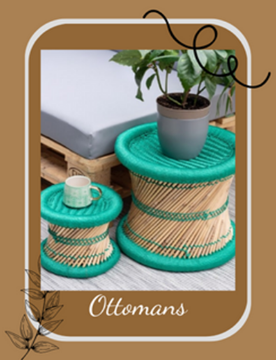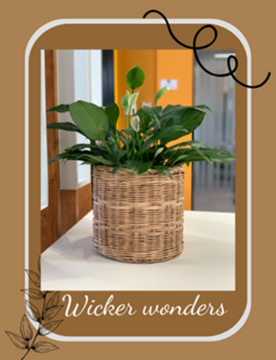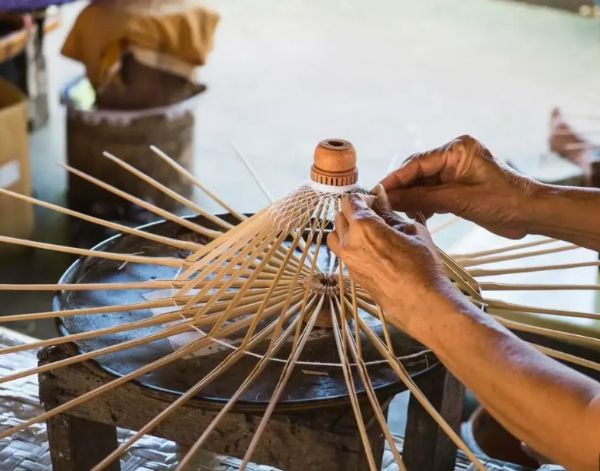Walking into a furniture showroom, you might wonder why that beautifully woven rattan chair costs three times more than its mass-produced counterpart, or why handmade bamboo dining sets command such premium prices. The answer lies in a fascinating world of ancient craftsmanship, sustainable practices, and meticulous attention to detail that transforms raw natural materials into functional art pieces.
Handmade bamboo and rattan furniture represents more than just seating or storage solutions—it embodies centuries of traditional techniques, environmental consciousness, and the irreplaceable human touch that machines simply cannot replicate. In an era where consumers increasingly value sustainability and authentic craftsmanship, understanding the true cost drivers behind these premium pieces becomes essential for making informed purchasing decisions.
From the careful selection of mature bamboo culms in remote Asian forests to the final hand-applied finishing touches in artisan workshops, every step in creating handmade bamboo and rattan furniture involves skilled labor, time-intensive processes, and premium materials. This comprehensive exploration will unveil the hidden factors that justify the higher price points of these exceptional furniture pieces and help you appreciate the true value they bring to your home and the environment.
The Art of Traditional Craftsmanship: Where Time Meets Skill
Master Artisans and Generational Knowledge
The creation of handmade bamboo and rattan furniture relies heavily on master craftsmen who have spent decades perfecting their skills. These artisans often learn their trade through generational knowledge passed down from parents and grandparents, creating a rich tapestry of traditional techniques that cannot be quickly replicated or mass-produced.
In countries like Indonesia, Philippines, Vietnam, and Myanmar, entire communities have built their livelihoods around bamboo and rattan craftsmanship. A single rattan chair might require 40-60 hours of skilled labor, with each weaving pattern demanding precision and experience that only comes from years of practice. Master weavers can create complex patterns entirely by memory, adjusting tension and spacing with an intuitive understanding that machines cannot match.
The Learning Curve Investment
Training new artisans represents a significant investment for furniture manufacturers. A craftsperson typically requires 2-3 years to achieve basic proficiency in bamboo and rattan work, and another 5-7 years to master advanced techniques like intricate weaving patterns, joinery methods, and finishing processes. This extended learning period means that skilled artisans command higher wages, directly impacting the final cost of handmade pieces.
The complexity of working with natural materials adds another layer to the skill requirement. Unlike uniform factory materials, bamboo and rattan vary in thickness, flexibility, and grain patterns. Experienced artisans can assess these variations instantly and adjust their techniques accordingly, ensuring consistent quality despite material differences.
Regional Specializations and Unique Techniques
Different regions have developed specialized techniques that contribute to the premium pricing of their handmade furniture:
Indonesian Craftsmen excel in creating elaborate rattan furniture with complex geometric patterns and multi-layered weaving techniques. Their traditional "anyaman" weaving style produces incredibly durable and visually stunning pieces.
Philippine Artisans are renowned for their bamboo furniture craftsmanship, particularly in creating innovative joint systems that eliminate the need for metal fasteners while maintaining structural integrity.
Vietnamese Craftspeople have mastered the art of combining bamboo and rattan in single pieces, creating hybrid furniture that leverages the best properties of both materials.
Myanmar Specialists are known for their intricate bamboo carving and detailed surface treatments that transform simple bamboo poles into ornate furniture components.
Premium Material Sourcing: The Foundation of Quality
Selective Harvesting Practices
The journey of premium bamboo and rattan furniture begins in carefully managed forests and plantations where sustainable harvesting practices ensure both quality and environmental responsibility. Unlike mass-produced furniture that uses any available material, handmade pieces require selective sourcing that significantly impacts costs.
Bamboo Selection Criteria:
- Age: Premium bamboo must be 3-5 years old for optimal strength and flexibility
- Season: Harvesting during dry seasons ensures lower moisture content and better durability
- Species: Specific bamboo varieties like Dendrocalamus asper or Bambusa oldhamii command higher prices due to superior properties
- Location: Bamboo grown in specific altitudes and climates produces stronger, more uniform culms
Rattan Quality Standards:
- Diameter consistency: Premium rattan canes maintain uniform thickness throughout their length
- Flexibility: High-quality rattan bends without breaking, requiring specific harvesting techniques
- Surface quality: The best rattan has smooth, unblemished surfaces without pest damage
- Length: Longer rattan canes are more valuable as they allow for continuous weaving without joints
Transportation and Storage Challenges
Moving raw bamboo and rattan from remote harvesting locations to workshops presents logistical challenges that add to material costs. These natural materials require specific transportation conditions to prevent damage, splitting, or moisture-related issues.
Proper storage facilities must maintain optimal humidity levels and provide protection from pests that can damage the raw materials. Many artisan workshops invest in climate-controlled storage areas and regular pest control measures, adding to operational costs that ultimately reflect in furniture pricing.
Sustainable Sourcing Premiums
Consumers increasingly demand furniture made from sustainably sourced materials, and this ethical sourcing comes with additional costs. Certified sustainable bamboo and rattan suppliers often charge premium prices because they:
- Implement reforestation programs to maintain forest ecosystems
- Provide fair wages to local harvesters and communities
- Follow strict environmental guidelines that limit harvesting quantities
- Maintain detailed supply chain documentation for transparency
- Invest in community development programs in harvesting regions
These sustainable practices, while environmentally beneficial, create additional costs that conscientious manufacturers pass on to consumers who value ethical sourcing.
Time-Intensive Production Processes
Hand-Weaving Complexity
The creation of handmade rattan furniture involves incredibly time-intensive weaving processes that cannot be rushed without compromising quality. A single dining chair might require 15-20 hours of continuous weaving, while complex pieces like peacock chairs or intricate storage baskets can take 60-80 hours to complete.
Weaving Process Breakdown:
- Preparation Phase (2-4 hours): Soaking rattan to achieve optimal flexibility, cutting to required lengths, and preparing the frame
- Base Weaving (8-12 hours): Creating the foundational structure that will support the entire piece
- Pattern Weaving (15-25 hours): Implementing decorative patterns that require constant attention to maintain consistency
- Finishing Touches (3-5 hours): Securing loose ends, adjusting tension, and quality inspection
Bamboo Joint Construction
Bamboo furniture construction involves sophisticated joinery techniques that require significant time investment. Unlike wood, bamboo's hollow structure presents unique challenges that master craftsmen have solved through innovative techniques developed over centuries.
Traditional Bamboo Joints:
- Lashed Joints: Using natural fibers or bamboo strips to create flexible, strong connections
- Mortise and Tenon: Adapting traditional woodworking joints for bamboo's unique properties
- Compression Joints: Utilizing bamboo's natural flexibility to create self-tightening connections
- Interlocking Systems: Complex joints that distribute stress across multiple contact points
Each joint type requires different preparation times and skill levels, with some advanced joints taking 2-3 hours to complete properly.
Finishing and Treatment Processes
Handmade bamboo and rattan furniture undergoes extensive finishing processes that ensure durability and aesthetic appeal. These treatments, applied by hand, require significant time and expertise:
Surface Preparation:
- Sanding: Multiple passes with progressively finer grits to achieve smooth surfaces
- Cleaning: Removing dust, debris, and natural oils that might affect finish adhesion
- Moisture Content Adjustment: Ensuring optimal moisture levels for finish application
Protective Treatments:
- Natural Oil Applications: Multiple coats of tung oil, linseed oil, or specialized bamboo oils
- Lacquer Finishes: Traditional lacquer applications that require precise timing and environmental conditions
- Wax Treatments: Hand-applied wax finishes that enhance natural grain patterns
Quality Control Inspections: Each piece undergoes multiple quality inspections throughout the production process, with experienced craftsmen identifying and correcting any defects before proceeding to the next stage.
Labor Costs and Fair Trade Practices
Skilled Artisan Compensation
The furniture industry has increasingly recognized the importance of fair compensation for skilled artisans, particularly in developing countries where much of the world's handmade bamboo and rattan furniture originates. This shift toward ethical labor practices has positively impacted pricing structures.
Artisan Wage Structures:
- Master Craftsmen: $15-25 per day (significantly above local minimum wages)
- Experienced Weavers: $10-18 per day
- Apprentice Artisans: $6-12 per day
- Specialized Finishers: $12-20 per day
These wages, while modest by Western standards, represent premium compensation in their local markets and reflect the specialized skills these artisans possess.
Workshop Overhead Costs
Artisan workshops maintaining high-quality standards face significant overhead costs that impact furniture pricing:
Facility Costs:
- Climate-controlled work environments to prevent material warping and cracking
- Specialized tool maintenance and replacement
- Safety equipment and training programs
- Quality control stations and testing equipment
Training and Development:
- Apprenticeship programs that support skill development
- Continuous education in new techniques and designs
- Cultural preservation initiatives that maintain traditional methods
- Health and safety training compliance
Fair Trade Certification Impact
Many premium handmade furniture manufacturers pursue Fair Trade certification, which requires adherence to strict labor and environmental standards. This certification process involves:
- Regular third-party audits of working conditions and wage practices
- Community development fund contributions (typically 2-5% of purchase price)
- Environmental impact assessments and mitigation measures
- Worker education and empowerment programs
The costs associated with Fair Trade compliance are reflected in final furniture prices but ensure that purchases support ethical manufacturing practices and community development.
Design Innovation and Customization
Contemporary Design Integration
Modern handmade bamboo and rattan furniture successfully bridges traditional craftsmanship with contemporary design sensibilities. This integration requires significant research and development investment from manufacturers who must balance authentic techniques with modern aesthetic preferences.
Design Development Process:
- Market Research: Understanding current interior design trends and consumer preferences
- Prototype Creation: Developing new designs that showcase traditional techniques in modern contexts
- Testing and Refinement: Ensuring new designs maintain structural integrity and functionality
- Production Scaling: Training artisans in new techniques while maintaining quality standards
Customization Services
Many premium handmade furniture manufacturers offer extensive customization options that add significant value but also increase production complexity and costs:
Available Customization Options:
- Size Modifications: Adjusting dimensions to fit specific spaces or requirements
- Color Variations: Custom staining or painting to match interior design schemes
- Pattern Customization: Modifying traditional weaving patterns or creating entirely new designs
- Hardware Selection: Choosing specific fittings, cushions, or accent materials
- Finish Options: Selecting from various protective treatments and surface finishes
Each customization requires individual attention from skilled artisans and often involves creating new templates or modifying existing production processes.
Limited Edition and Artistic Pieces
Some manufacturers collaborate with renowned designers to create limited edition pieces that command premium prices due to their artistic merit and exclusivity. These collaborations often involve:
- Extensive design development periods spanning 6-12 months
- Creation of unique production techniques or material combinations
- Limited production runs that increase per-piece costs
- Enhanced documentation and certification processes
- Specialized packaging and presentation requirements
Quality Control and Durability Standards
Multi-Stage Quality Inspections
Handmade bamboo and rattan furniture undergoes rigorous quality control processes that significantly exceed those of mass-produced alternatives. These comprehensive inspections occur at multiple production stages:
Material Inspection Stage:
- Visual examination for defects, pest damage, or structural weaknesses
- Moisture content testing to ensure optimal levels for processing
- Flexibility and strength testing of individual bamboo culms and rattan canes
- Color and grain consistency evaluation for aesthetic uniformity
Production Stage Inspections:
- Joint integrity testing during assembly processes
- Weaving tension and pattern consistency verification
- Dimensional accuracy measurements against design specifications
- Surface quality assessment throughout finishing processes
Final Quality Assurance:
- Structural load testing to verify weight capacity ratings
- Finish durability testing including scratch and moisture resistance
- Complete visual inspection for aesthetic flaws or inconsistencies
- Packaging and protection verification to prevent shipping damage
Durability Testing Protocols
Premium handmade furniture manufacturers implement comprehensive durability testing protocols that ensure their pieces withstand years of regular use:
Structural Testing Methods:
- Static Load Testing: Applying maximum weight loads to verify structural integrity
- Dynamic Load Testing: Simulating repeated use patterns to identify potential failure points
- Environmental Stress Testing: Exposing pieces to temperature and humidity variations
- Joint Stress Analysis: Focusing on connection points that experience the most stress
Longevity Projections: High-quality handmade bamboo and rattan furniture, when properly maintained, typically lasts 15-25 years, significantly longer than mass-produced alternatives that might require replacement every 3-5 years.
Warranty and Support Services
Premium manufacturers often provide extensive warranty coverage and customer support services that add value but also increase operational costs:
Warranty Coverage:
- Structural integrity guarantees typically spanning 5-10 years
- Finish quality warranties covering 2-3 years
- Hardware replacement services for the life of the product
- Repair and restoration services at discounted rates
Customer Support Services:
- Maintenance guidance and care instruction provision
- Seasonal care reminders and tips
- Replacement part availability for damaged components
- Professional cleaning and restoration referrals
Shipping and Logistics Considerations
International Shipping Challenges
The global nature of the handmade bamboo and rattan furniture market creates significant logistical challenges that impact pricing. Most high-quality pieces originate in Southeast Asian countries and must be transported to markets worldwide.
Shipping Complexities:
- Fragility Concerns: Handmade furniture requires specialized packaging to prevent damage during transport
- Size and Weight Variations: Irregular dimensions make container optimization challenging
- Climate Control: Maintaining appropriate humidity levels during long ocean voyages
- Documentation Requirements: Complex international trade documentation and customs procedures
Packaging Innovations: Premium manufacturers invest heavily in packaging innovations that protect furniture during shipping:
- Custom-fitted foam inserts for individual pieces
- Moisture-resistant wrapping materials
- Shock-absorbing container systems
- Temperature and humidity monitoring devices
Last-Mile Delivery Services
The final delivery of handmade furniture often requires specialized services that add to overall costs:
White Glove Delivery Options:
- Professional assembly services by trained technicians
- Placement and positioning within customer homes
- Packaging material removal and disposal
- Basic maintenance instruction provision
Installation and Setup Services: Many complex pieces, particularly modular bamboo furniture systems, require professional installation that includes:
- Site preparation and measurement verification
- Component assembly using specialized tools
- Quality inspection upon completion
- Customer education on proper use and maintenance
Regional Price Variations and Market Factors
Geographic Cost Differences
The cost of handmade bamboo and rattan furniture varies significantly across different global markets due to various regional factors:
Asian Markets (Origin Regions):
- Lower labor costs result in more affordable pricing
- Reduced shipping expenses for local consumption
- Greater artisan availability and competition
- Cultural familiarity with traditional techniques
North American Markets:
- Premium pricing due to importation costs and taxes
- Higher retail markups to cover distribution expenses
- Increased demand for sustainable furniture options
- Limited local artisan availability driving import dependence
European Markets:
- Strict quality and safety standards adding compliance costs
- High import duties and environmental regulations
- Strong demand for ethically produced furniture
- Premium positioning in luxury home furnishing segments
Emerging Markets:
- Growing middle-class demand for quality furniture
- Developing distribution networks and retail infrastructure
- Increasing awareness of sustainable living benefits
- Price sensitivity requiring careful positioning strategies
Currency Fluctuations Impact
International trade in handmade furniture faces significant challenges from currency exchange rate variations:
Manufacturing Cost Impacts:
- Raw material sourcing costs fluctuate with currency changes
- Artisan wages become more or less competitive internationally
- Equipment and tool importation costs vary with exchange rates
- Facility overhead expenses affected by currency stability
Pricing Strategy Adaptations: Manufacturers employ various strategies to manage currency risk:
- Long-term pricing contracts with key suppliers
- Currency hedging for major international transactions
- Regional pricing adjustments based on local economic conditions
- Strategic inventory management to buffer against rate fluctuations
Sustainability Premiums and Environmental Costs
Carbon Footprint Considerations
Environmentally conscious consumers increasingly factor carbon footprint into their purchasing decisions, and handmade bamboo and rattan furniture manufacturers invest significantly in reducing their environmental impact:
Carbon Reduction Initiatives:
- Local sourcing programs to minimize transportation emissions
- Renewable energy adoption in production facilities
- Waste reduction and recycling programs
- Carbon offset programs for international shipping
Sustainability Certifications: Multiple certification programs add costs but provide valuable environmental credentials:
- Forest Stewardship Council (FSC) certification for sustainable sourcing
- Carbon Neutral certification for production processes
- ISO 14001 environmental management system compliance
- GREENGUARD certification for indoor air quality standards
Circular Economy Integration
Progressive manufacturers embrace circular economy principles that add initial costs but provide long-term value:
End-of-Life Programs:
- Furniture take-back and recycling services
- Refurbishment and resale programs for used pieces
- Component harvesting for repair services
- Biodegradable finish and treatment options
Design for Durability:
- Modular construction allowing component replacement
- Timeless design aesthetics to prevent style obsolescence
- Upgrade and modification services to extend product life
- Comprehensive maintenance programs to maximize longevity
Technology Integration in Traditional Crafts
Modern Tools in Traditional Processes
Contemporary handmade furniture production increasingly integrates modern technology while maintaining traditional techniques:
Precision Measuring Tools:
- Digital calipers for exact component dimensions
- Moisture meters for optimal material conditions
- Tension gauges for consistent weaving quality
- Quality inspection cameras for detailed defect analysis
Enhanced Finishing Equipment:
- Controlled atmosphere spray booths for consistent finishes
- UV curing systems for rapid, durable coating application
- Precision temperature control for optimal treatment conditions
- Dust collection systems for healthier work environments
Digital Design and Prototyping
While maintaining hand-crafted production methods, many manufacturers utilize digital tools for design development:
Computer-Aided Design (CAD):
- 3D modeling for complex joint development
- Stress analysis simulation for structural optimization
- Pattern generation for consistent weaving designs
- Material optimization for waste reduction
Prototyping Technologies:
- 3D printing for joint testing and development
- CNC machining for precise template creation
- Virtual reality for design visualization
- Digital pattern projection for weaving guidance
Market Positioning and Brand Value
Luxury Market Positioning
Handmade bamboo and rattan furniture increasingly positions itself in luxury market segments, commanding premium prices through careful brand development:
Luxury Brand Elements:
- Heritage storytelling emphasizing traditional craftsmanship
- Artisan profiles and workshop documentation
- Limited edition and exclusive design offerings
- Premium packaging and presentation
- Concierge-level customer service
Celebrity and Designer Endorsements: Strategic partnerships with interior designers and lifestyle influencers help establish premium positioning:
- Featured placements in high-end residential projects
- Editorial coverage in luxury lifestyle publications
- Social media collaborations with design professionals
- Trade show participation in premium furniture exhibitions
Cultural Authentication
Authentic cultural positioning adds significant value to handmade furniture:
Cultural Storytelling:
- Historical context and traditional technique documentation
- Artisan community profiles and cultural preservation stories
- Regional technique explanations and cultural significance
- Educational content about traditional furniture roles in different cultures
Authenticity Verification:
- Certificates of authenticity for traditional techniques
- Artisan signatures or workshop identification marks
- Cultural organization endorsements and partnerships
- Museum quality documentation and provenance tracking
Conclusion
The premium pricing of handmade bamboo and rattan furniture reflects a complex interplay of factors that extend far beyond simple manufacturing costs. At its core, this pricing structure represents the true value of preserving ancient craftsmanship traditions while meeting modern sustainability and quality standards. Every piece embodies the accumulated knowledge of master artisans whose skills have been refined over generations, creating furniture that transcends mere functionality to become functional art.
The investment in handmade bamboo and rattan furniture pays dividends across multiple dimensions. Environmentally, these pieces support sustainable forestry practices, carbon sequestration through bamboo growth, and reduced industrial manufacturing impacts. Socially, purchasing decisions directly support artisan communities, preserve cultural traditions, and promote fair labor practices in developing economies. Economically, the superior durability and timeless aesthetic appeal of handmade pieces provide better long-term value compared to disposable mass-produced alternatives.
Frequently Asked Questions (FAQs)
1. Why does handmade bamboo furniture cost significantly more than mass-produced alternatives?
Handmade bamboo furniture commands higher prices due to several key factors that mass-produced alternatives cannot match. The primary cost driver is the skilled labor required – master craftsmen spend decades perfecting their techniques, and a single piece might require 40-80 hours of specialized hand-work. Additionally, handmade pieces use premium, selectively sourced bamboo that's harvested at optimal ages (3-5 years) and processed using traditional methods that preserve the material's natural strength and beauty.
2. How can I verify that bamboo or rattan furniture is genuinely handmade and not machine-produced?
Distinguishing genuine handmade bamboo and rattan furniture from machine-produced pieces requires examining several key characteristics. First, look for slight variations in weaving patterns, joint construction, and finish application – these natural inconsistencies indicate human craftsmanship rather than machine precision. Handmade pieces often feature visible tool marks, slight asymmetries in patterns, and variations in bamboo diameter that reflect the natural material's characteristics.
3. What factors should I consider when evaluating the cost-effectiveness of expensive handmade bamboo furniture?
When evaluating expensive handmade bamboo furniture, consider multiple factors beyond the initial purchase price to determine true cost-effectiveness. Start with longevity analysis – high-quality handmade pieces typically last 15-25 years compared to 3-5 years for mass-produced alternatives. Calculate the annual cost by dividing the purchase price by expected lifespan; often, premium handmade furniture offers better long-term value despite higher upfront costs.
4. Are there specific maintenance requirements that justify the higher cost of handmade rattan furniture?
Handmade rattan furniture does require specific maintenance practices, but these requirements actually justify rather than negate the higher cost investment. The premium materials and construction methods used in handmade pieces respond well to proper care, extending their lifespan significantly beyond mass-produced alternatives.








